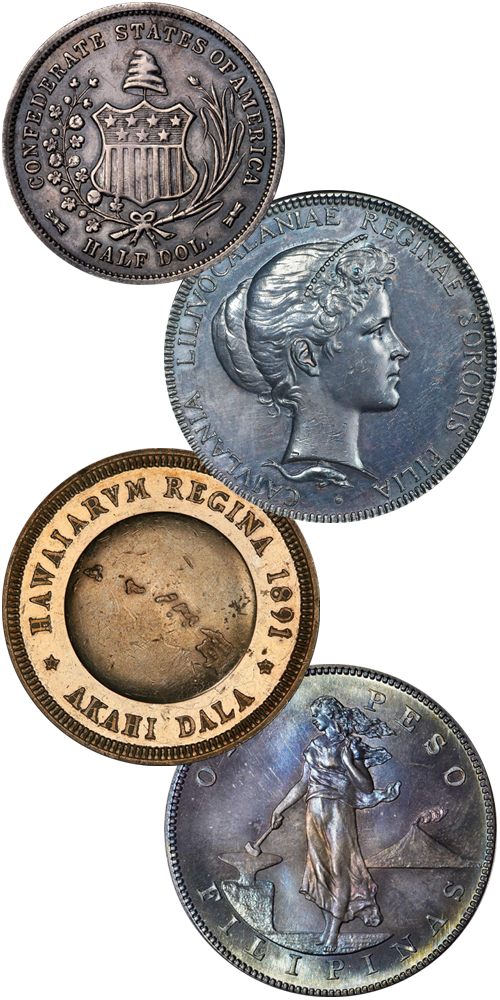In the closing years of the 19th century, by virtue of the U.S. victory over Spain in the Spanish-American war, several islands came under the sovereignty of the United States including the Philippines and Puerto Rico.
Coins were struck for the Philippines at both the Philadelphia and San Francisco mints from 1903 to 1919 in denominations of Half, One, and Five Centavos in bronze and copper nickel, and in denominations of 10, 20, 50 and 100 Centavos (Peso) in silver. In 1920, operations were transferred to the Manila mint began and continued until the Japanese occupation in 1941. The U.S. mints at Philadelphia, Denver and San Francisco again took over the mintage of coins for the Philippines during 1944 and 1945. Of interest on these issues is the reverse design, which features an eagle atop a shield of stars and stripes, with the words “UNITED STATES OF AMERICA” around the rim. The United States granted full independence to the Philippines in 1946.
The coins of the U.S. Territory of Puerto Rico are often of interest to U.S. numismatists. Puerto Ricans were granted U.S. citizenship in 1917, and talk of granting the island statehood has been going on for decades. The Guidebook of United States Coins lists the Puerto Rican issues of 1896 in five denominations; 5, 10, 20, 40 Centavos, and One Peso.
The early coinage of our fiftieth state, Hawaii, have long been collected by many U.S. numismatists. A large cent was struck privately in the United States in 1847 for King Kamehameha III, put proved unpopular with the Hawaiian people. In 1883, a series of four silver coins designed by Charles Barber was struck at the San Francisco Mint. These were in denominations of 10, 25, and 50 cents, and one dollar and depicted King Kalakaua I facing right. In addition, a few pattern pieces of 12 ½ cents were made as well as a five-cent coin in 1881.
While the mintages of the four silver pieces were generous enough, they were officially withdrawn in 1900 when Hawaii became a U.S. territory, and most of the larger denomination issues were subsequently melted. Private firms also issued tokens for local use at Hawaiian company stores. Known as Plantation tokens, about twenty different pieces were made between 1860 and 1891. All are quite rare today.
Though not a possession or territory of the United States, coins of the Confederate States are often grouped with these. In point of fact, the Confederacy never issued a circulating coin. The Confederate Cents of 1861 are now all thought to be fantasy pieces struck in the 1870s by Robert Lovett Jr. in Philadelphia. This includes the pieces struck in copper-nickel, once believed to be “originals” as well as restrikes made in copper, gold and silver.
Four original Confederate half dollars were struck on a hand press, and given to various southern dignitaries. These featured a federal obverse bearing the date 1861 and a reverse featuring a shield beneath a liberty cap in a wreath of cotton. The reverse die was located in New Orleans in 1879, and eventually sold to J.W. Scott & Co. of New York, who produced and sold “restrikes” with both the 1861 Seated Liberty obverse as well as his own obverse with text describing the origin of the half dollars.







